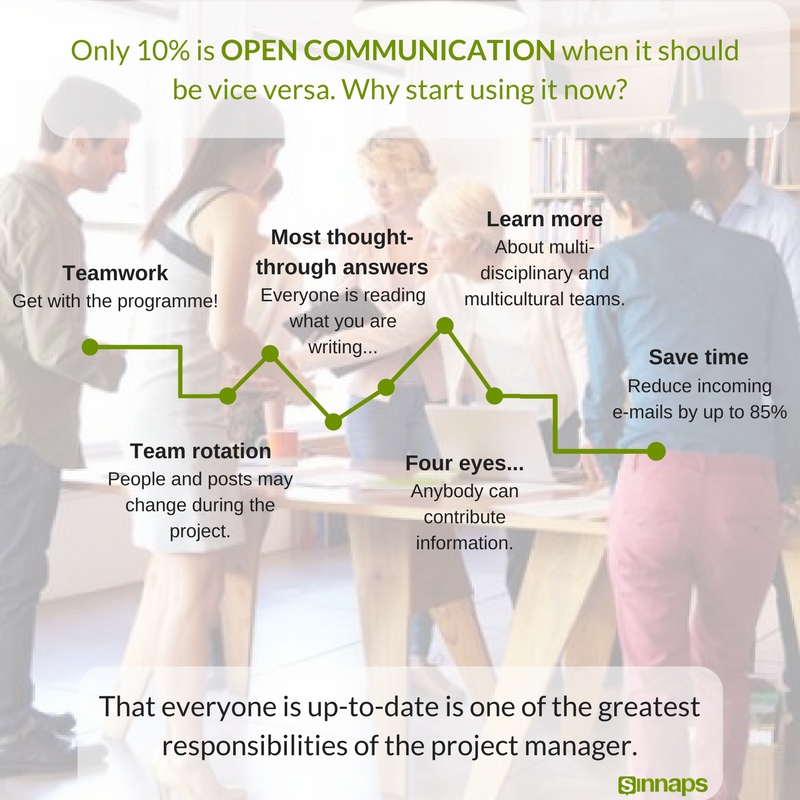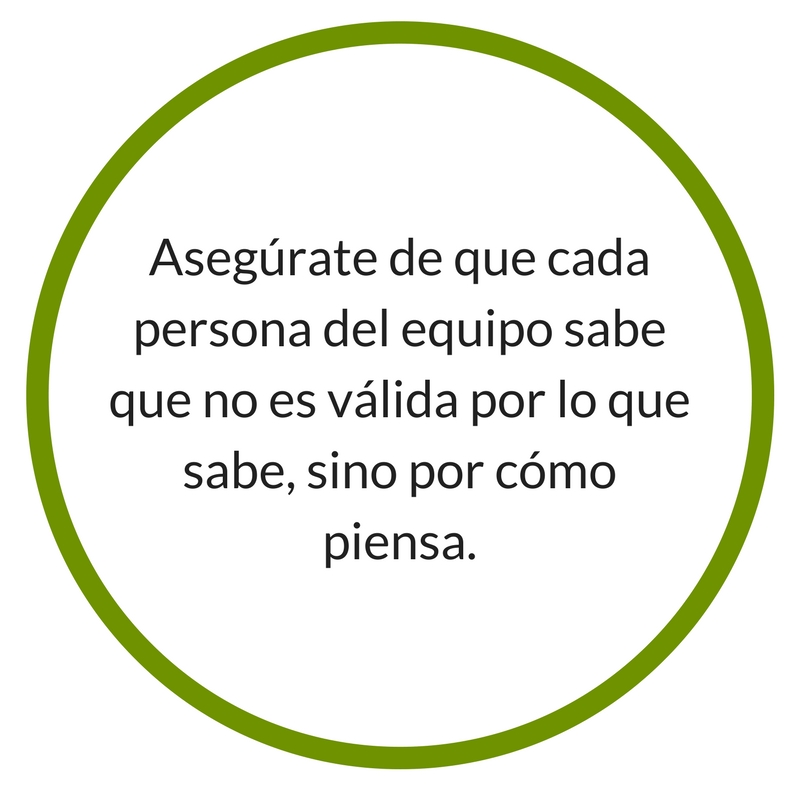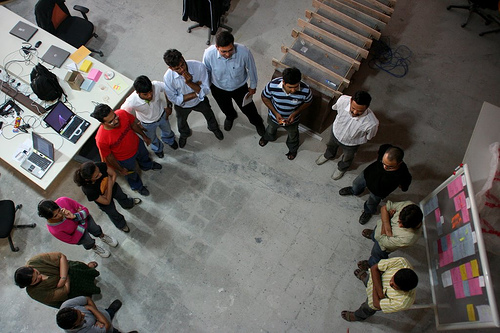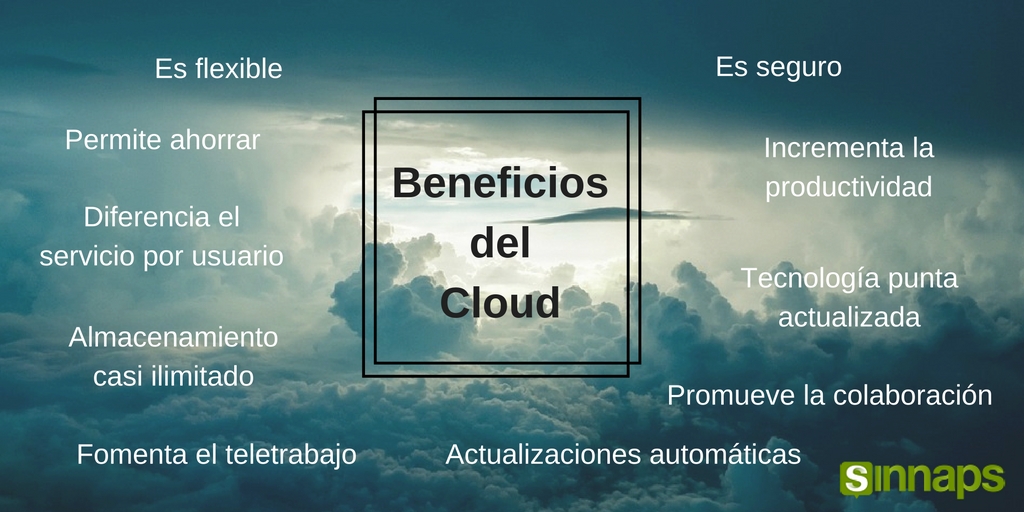Índice
So, we have defined the project, got realistic planning and also defined the milestones that will let us pursue the project within a specific time, as we have seen in the previous lessons in this free Project Management course.
Now we have to speed things up and hit cruising speed. For that, we will learn to use communication media in a company to speed some up and slow others down, balancing out the rhythm of the team.

The Project Manager (PM) must be able to make the parts of the team go at the necessary speed. Depending on the level of work, dedication to the project, complexity and availability of resources, we may require different activities to take place at different speeds.
In the end, you always have a critical path defining the length of your project, no matter whether or not you have identified it. That is why many of the activities not on your critical path are going to give you a certain clearance. Make the most of this clearance to square away resource use and activities.
So, although you may not be aware, you have a load of activities which need to be undertaken at different speeds. Communication will be your rocket fuel to feed the project and enable you to manage the day-to-day speed.
If everyone has the information necessary to continue, your project will progress as fast as possible. If you lose the thread, communication gets distorted or information disappears, then you have the wrong fuel on-board. Perhaps you will keep moving forward, but I can assure you that your engine will seize up and you will have to push the car.
With proper communication, everything moves faster. Activities cannot take place without communication. When part of the team does not know how to continue onwards or does not have access to the necessary information, everyone will be slowed down.
In this lesson, I cannot give an explanation of a specific tool nor a particular communication method. What I can do is try to define the communications framework in a project, as well as describe a series of ‘good practices’ which, in my case, I have checked out and know work well. ✌️
Open or closed communication?

Well, there are two ways. The first is the most incorrect way used by most companies to communicate within the work teams. Sending emails and speaking to the person you need to talk to. This may seem logical, but in the next paragraph I will try to convince you otherwise.
The second way to communicate – the one I have found to be the best – is using open communication. Basically, this means everything that is said is public to all project members. Recent studies show that 85% of e-mails are eliminated through the use of project communication tools. I do not know if it is that high, but I assure you it works and is better for these reasons:

— First off, you are working in a team, so get with the programme! Almost all the information in a project affects nearly every part of the team directly or indirectly. You never know who might be interested and, 70% of the time, we do not know what 90% of the team is doing. This is normal.
For this very reason, by using open communications platforms, we can make all the project information public. Your project platform should be a type of Google, where you can access all the useful information, depending on your interests. Can you imagine Google pages aimed at specific people? That would really slow down the development process…
— What is more, in 99% of cases, we need to speak to a person based on their responsibilities or position in the project and not according to their individual profession. Can you imagine them changing jobs? It is very likely. Or new people with new responsibilities appear. If that happens, it is very important that this person has access to all the information so they can get up-to-date. Something that is impossible with e-mail.
— Furthermore, open communication leads to two very important things:
The first is that people think a little before answering anything.
And the second, which is directly linked. Open communication invites anybody to provide an opinion and contribute. Four eyes are better than two, right? Thus, it is good that anybody from the project can contribute information at any time. Hence, the importance of assertive communication so everyone expresses their opinions openly.
This is exactly what the new culture of multi-disciplinary and multicultural teams is all about. The more different the profile, the more enriching the solutions.
— Open communication allows us to learn more. As everything is published, we can see how past problems were solved and learn from or avoid them. I can take a past project, find conversations and learn from them.
If this topic interests you, you can see further reasons why open communication should be used in this post.
Both open and closed communications are necessary, of course. However, typically 90% of communication is closed and only 10% open, when it should be the opposite. Transparency and assertive communication at work.
In what cases will we use closed communication?
If we need to speed up part of the project. We need to pass information from one activity to another to advance work. We will not do this through open communication given the activity has not concluded, and the results are not official and still susceptible to change.
When we need to run an ‘unofficial’ test, this is best conducted through closed communication, too. Many projects feature parallel work which is not part of the official project, either because it is for another project or because we are using resources we should not be, etc. So, we want to deal with this in the closed way so as not to confuse the remainder of the team.
I know it is normal that open communication is hard for members of a team. This is the result of prudence, embarrassment, custom, fear, pride or no wish to share. Generally speaking, it is difficult for us to communicate publicly at the start.
So, as PM, it is your responsibility to make it happen! Do this by trying to publish everything in your project via communications platforms to which the whole team is connected. Tell your team in person that you have written to them on the platform. Publish documents and refer to them in meetings, etc. You can use these little tips to boost open communication. It is worth it.😎
 The most important thing: ensure every member of the team knows they are there on the project not for what they know, but for the way they think. They should not be afraid to say what they know, even if it is little. This way you engender their self-confidence and, logically, confidence in the team. Creativity and the work environment will thank you!
The most important thing: ensure every member of the team knows they are there on the project not for what they know, but for the way they think. They should not be afraid to say what they know, even if it is little. This way you engender their self-confidence and, logically, confidence in the team. Creativity and the work environment will thank you!
Conversely, in terms of efficiency, what is important about using open communication is not so much that the communication reaches the relevant person, rather the fact that the information the team needs is accessible whenever they need it.
If you foster the use of an open communication platform, you will be enhancing self-sufficient workers. When they need to find information, they will know to look actively and be able to find it on their own. The project will move faster, I can tell you.
So, responsibility for ensuring all the information is accessible lies with the PM; however, it is up to the individual to ensure they remain informed. This is, of course, far more efficient.
What tools do we use for more effective communication?
When I talk about communication, I mean it in the broadest sense possible. This means not limiting it to verbal or written communication, but rather we need to think about graphic communication as a further resource among the main effective communication techniques in the workplace.
There are many visual/graphic management tools. There are also many ‘Lean’ techniques which favour visual management: SWOT, fishbone diagrams, spider diagrams, etc. However, the most powerful communications tool in a project is none of the above; it is not chat or e-mail; it is planning (of whatever sort).
The most powerful communications tools you have is the PLANNING. That is why I started to develop Sinnaps. In it you can communicate times, priorities and, above all, expectations in an easy-to-understand highly visual form. Hence, the importance of technical communication.

The short, medium and long-term planning is our project map. It is where we indicate where we have to go, where we have to get to and how we are going to do so. And if we also use online planning tools, its possibilities multiply. They become platforms where everyone can info-dump and visualise it in an organised form.
If you get used to using planning as a communication tool, you ensure the whole team will always be up-to-date with everything. Not to mention its role in effective communication strategies with the client.
Planning…
- Is visual and self-explanatory
- Communicates the project situation quickly
- Standardises information between projects
- Manages the team’s expectations
- May be predictive yet agile at the same time
- Is objective
- Provides reliability
- Is a wonderful tool to avoid risks and manage changes
For example, we use our planning (available to all) not only to explain the work far better in meetings, but also to chat through it and we know exactly when someone has validated a task or changed a duration, etc. You can see things very clearly in this gif – I hope it will inspire you. 😉

I know, I am a huge fan of planning… It is ideal to manage abstract information, but not very practical for managing qualitative abstract information. It is necessary to have at hand alternative tools to manage other types of information. No just conversations, but also documents, reports, estimations, simulations and scenarios.
We use Sinnaps in the company, obviously, but we also use a wide range of additional tools to communicate to each other in different contexts. We love many of the collaborative communications applications. 😎
Here are some of the apps we use for internal company communications. Perhaps they will be of assistance.
— Sinnaps: for direct communication within the plans for our projects.
— Google Docs: to manage documents in common. In fact, the vast majority of documents we have are in the Google Drive. I am writing this text on one of them.
— We also use WhatsApp for general notifications for groups or departments.
— Google Hangouts and Skype: for video conferences.
— Youtrack: to communicate the status of incidents or bugs in the application.
— Sentry: warns us about server errors.
— Mixpanel: enables us to understand and communicate in an automated way with new users.
— Tawk: serves for us to communicate with users and agents via instant chat in the application.
— Revue: is ideal to send newsletters to subscribers.
— MailChimp. serves to create campaigns and mailing lists, like the one for this course.
— Mandril: managers all the transactional Sinnaps mail.
— Slack: integrates some of the preceding tools, like Sentry, into our mobiles, creates themed channels, etc.
— Twitter, Facebook & LinkedIn: to maintain constant feedback with influencers and followers. On occasion, social networks are even highly useful as a user service instrument.
— Canva: here, we design posters, computer graphics, advertising dossiers, etc.
— Adioma: helps us to make easy-to-understand computer graphics and timelines.
A lot of tools as you can see, and there are many more. In fact, here is a list of free communications tools which might be of use to you. The reality is nowadays there are a great many online tools – both free and not – and you should not limit yourself to any single one.
I recommend this list of free Applications for productive work.
Do not be afraid to use a new app, particularly if it can be incorporated into your daily work. What is important is that you choose one as your main tool, while all the others pivot around the work done on it.
In our case, it is Sinnaps, but it could be Kanban, or whatever, another planning tool or an internal CRM of the SAP type. The key factor is that as many as possible of them are collaborative so you can communicate – without losing information rights. In other words, it should be clear at all times who is responsible for each task, who has completed an activity, etc. Many of these apps have an integrated log with the actions being undertaken in the project.
The Monday meeting
As PM, one of the most important things you have to do is to foster and manage communication with and among the team.
However, not all communication is dependent on tools. Most of it is linked to the way we work. Try to implement habits in your way of working that promote communication. One of the habits that is highly embedded and helps communication enormously at Sinnaps is the Monday morning meeting.
First thing every Monday, we meet to explain to everyone what we will be working on this week. Each of us takes a couple of minutes to explain what s/he is going to be doing over the next five days and our expectations about this.

In my experience in big companies, when we had a Monday meeting, it was impossible for everyone to talk about what they were working on. Thus, the head of department gave a brief summary of what was going on in each of the projects on which they were working. Then, there was a Q&A where all of us could ask whatever we wanted about whichever project.
Strangely, these meetings were known as ‘stand-up meetings’. This meant that nobody got too comfortable, ensuring nobody got too carried away… 😅
Will you help me out? 😉 If you liked this content, please share it on social networks. Thank you!!
Let me be clear: this meeting was not a monitoring tool but rather a communication tool. For me, it is particularly useful to know what each member of the team is working on, so each of them know, too.
Very often based on what someone says, synergies appear with other things which other people are working on and they provide mutual assistance. It is weird, but normally more technical teams start to look at the nitty gritty and we have to ask them to talk about this elsewhere.
It is possible that someone who is elsewhere will not have been able to connect. Therefore, when the meeting is over, I tend to call to let them know what is planned for the remainder of the week.
Everything is already displayed on the planning. However, we must remember that the plan is an approximation. So, we have to regularly update the information based on what has been discussed in these meetings. In any case, with meetings every Monday, we are obliged to keep the plans up-to-date, at least on a weekly basis.
The cloud ☁️
Within the effective communication strategies and skills, we have the cloud – another tool from the present century.
Your work is getting more complicated every day. We are more demanding, more careful and more complete. This means that our projects are getting more complex. Building a house today is far more complicated than it was 10 years ago. Because the house is much better, there are more regulations, more qualities, more demands, etc.
It is the same for everything. Trying to manage a project in the same way as ten years ago is crazy and utterly foolish.

Nowadays, everything has to be fast, instantaneous and easy-to-share. And communication has to be the same. Being realistic, the only way to achieve this is by using the cloud.
Managing a project without using the cloud today is reckless. Stop worrying about safety because your data is far safer in an online company than in the server in your office.
I am not saying get rid of your safety measures, you do not need to do so. If you follow these five basic rules to protect your data, it will be enough. There are many ‘smart’ people thinking about how to protect your data. And the advantages of working online are absolutely worthwhile.
☞ Add a link to the document in your server, instead of attaching a document.
☞ Use slightly complicated passwords and change them from time to time.
☞ Update your browser and operating system regularly.
☞ Do not connect to Wi-Fi networks you do not know.
☞ Avoid particular sites and do not download indiscriminately.
This should cover all the necessary security. There are data protection laws and a great many European and international regulations (particularly European) which ensure the security of your data.
In our case, some of the Sinnaps team work remotely and we only see each other in person at the end of each quarter. None of this would be possible without the cloud. In fact, all the documents we generate are worked on in the cloud collaboratively. We have no hard drives or servers or back-up copies in the office.
We trust our service providers. Thanks to having everything in the cloud, we can often work from home with no problem at all. In fact, it is often more productive to work from home. What is more, although we all speak to each other frequently, we never know if the other person is at home or not, and the truth is it does not matter… This may sound strangely utopian, but today all companies should be working like this.
Cloud use, realistic planning and suitable online tools may mean our communications are so smooth that we do not even need to be in the office. This type of communication enables you to work more and better and lead a better life – something that, in the end, has an impact on the company. But, in order to make it all happen, it is necessary to ensure company or project communications strategy is properly implemented from the very start.
Advice (from my own experience ;))
So, that brings us to the end of this lesson in the online Project Management course, covering how to define a project communications strategy. Just remember the following:
- Communication is a very powerful tool by which to manage project speed.
- If everyone has the freedom, means and custom of communicating freely, then they can work freely.
- Managing the media and ensuring that everyone is up-to-date is one of the greatest responsibilities of the project manager.
- Try to maximise use of open communications.
- Planning is your best communication tool You do not want anyone to work in isolation.
- Use collaborative tools.
- Have Monday morning meetings.
- Work in the cloud.
Questions? Don’t be shy! I will answer all of them ✌
And that’s the end of this lesson. I will update it with your feedback, so don’t hesitate send comments or contributions from your experience so other users can have their doubts dispelled.
By the way… You do not need to be a user to follow the course, but I would encourage you to try the Business account in the Sinnaps app to make your work both more productive and more effective. You will see that you can work faster and better. Use the remaining time for what you most enjoy doing!
See you next time!

Richard de Sinnaps – Lets get things done!!
Will you help me out? 😉 If you liked this content, please share it on social networks. Thank you!!

